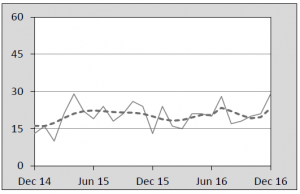
29 Nov Are your patients driving while drowsy in December??
“The truth is people who cut corners with their sleep function below their best. They are not as mentally sharp, as vigilant, as attentive or as patient as they would otherwise be,” Sleep Health Foundation director, David Hillman. Such a statement calls driving, as an activity where underperformance and deficit attention have direct and severe consequences, to mind.
A survey study from the University of Adelaide reported that 29% (out of a population of 1,011) of people drive when drowsy at least every month. These results varied widely between age groups, but have severe implications nonetheless, with 30% of those aged 25-34 indicating that they drive when drowsy at least once a week. The survey further indicates that sleep-related issues affect 33-45% of adults. There is inherent negative response bias in such a survey. People are less likely to indicate issues relating to competence despite assured confidentiality. As a corollary, the results of the survey pertaining to driving can only be considered an underestimate.
Studying the sleep patterns of shift workers, with varying levels of fatigue, provides a more robust insight into driving risks and tiredness. A 2007 study had 895 nurses’ complete logbooks on a daily basis, providing information about work hours, sleep duration, fatigue levels at work, and drowsy driving experiences. The study concludes that sleep duration, issues with sleep, and self-reported fatigue resulted in significantly increased likelihood of drowsy driving episodes. Alarmingly, 596 of the population reported experiencing drowsy driving at least once. The study is a natural experiment. If I increase fatigue, do I increase driving risk? The answer is unsurprisingly a firm yes (Scott et al., 2007).
A study wrought from the collaboration of Université Bordeaux, and Stanford University compared objective measures of sleepiness with driving performances in patients suffering from excessive daytime sleepiness. Driving was evaluated with a 90-minute real-life driving session, where inappropriate line crossings were counted. These correlated with MWT scores, where patients with increased sleepiness according to the MWT had significantly more line crossings, and hence poorer performance, than control drivers (Philip et al., 2007)
Meanwhile, December is the most dangerous month to be on the road. December has the distinction of increasing road deaths in the last five years. From December 2015 to December 2016, there was a 6.4% increase in road deaths. It must not be lost on us that in a month that for many is one of relaxation and celebration, we must be most vigilant.
Linda D. Scott, Wei-Ting Hwang, Ann E. Rogers, Tami Nysse, Grace E. Dean, David F. Dinges; The Relationship between Nurse Work Schedules, Sleep Duration, and Drowsy Driving, Sleep, Volume 30, Issue 12, 1 December 2007, Pages 1801–1807, https://doi.org/10.1093/sleep/30.12.1801
Philip, P., Sagaspe, P., Taillard, J., Chaumet, G., Bayon, V., Coste, O., Bioulac, B. and Guilleminault, C. (2008), Maintenance of Wakefulness Test, obstructive sleep apnea syndrome, and driving risk. Ann Neurol., 64: 410–416. doi:10.1002/ana.21448
http://www.abc.net.au/news/2017-02-08/sleep-study-finds-alarming-number-of-dozy-drivers-on-our-roads/8250780


